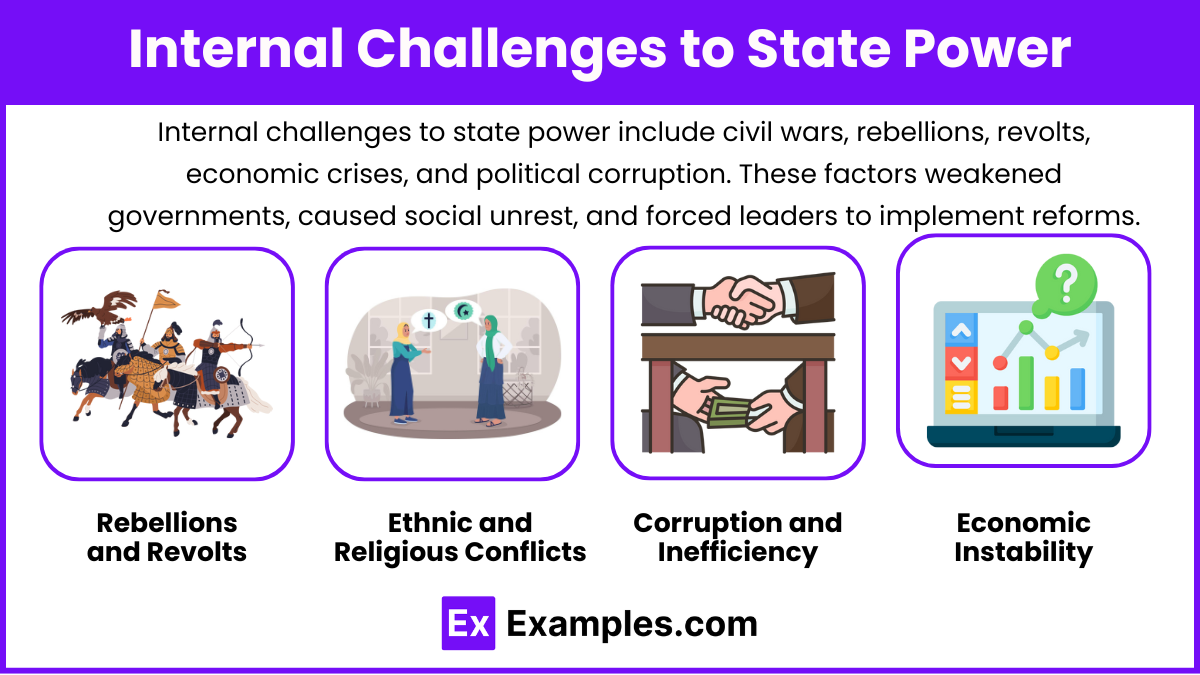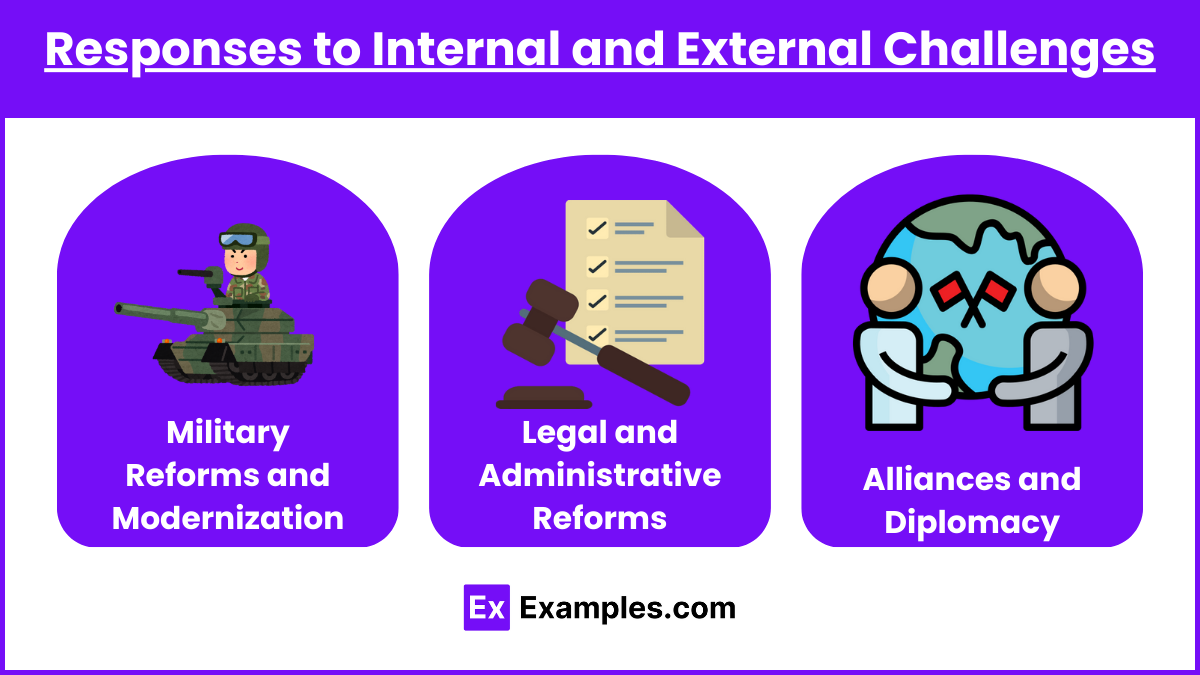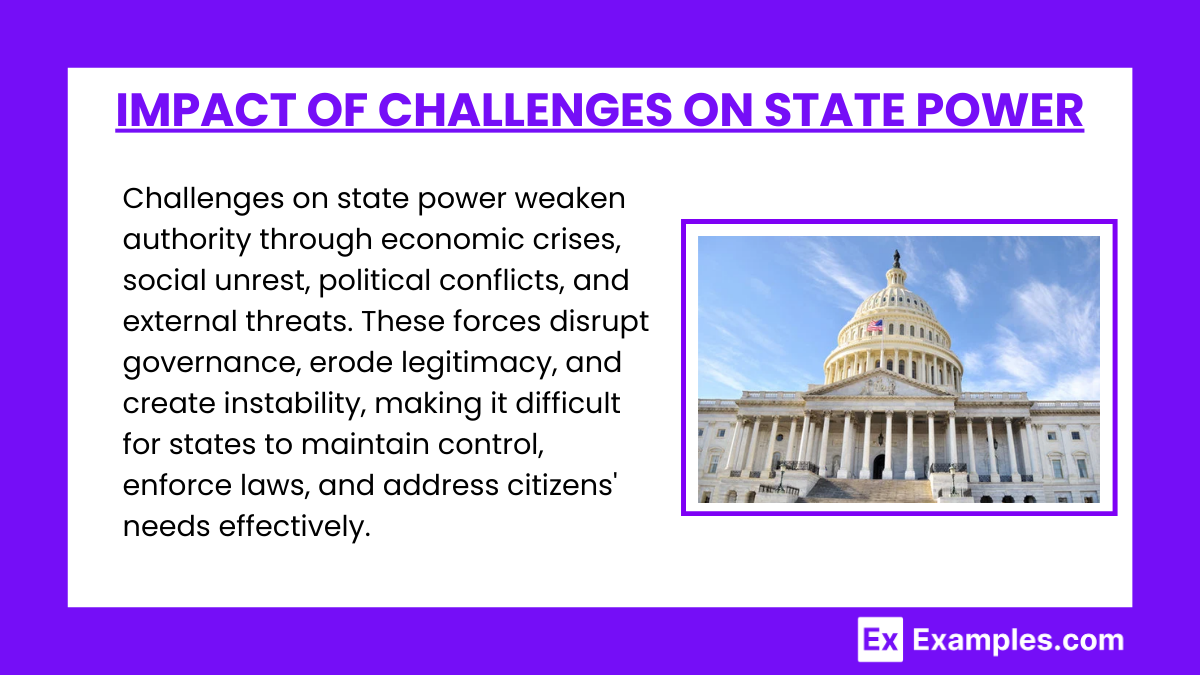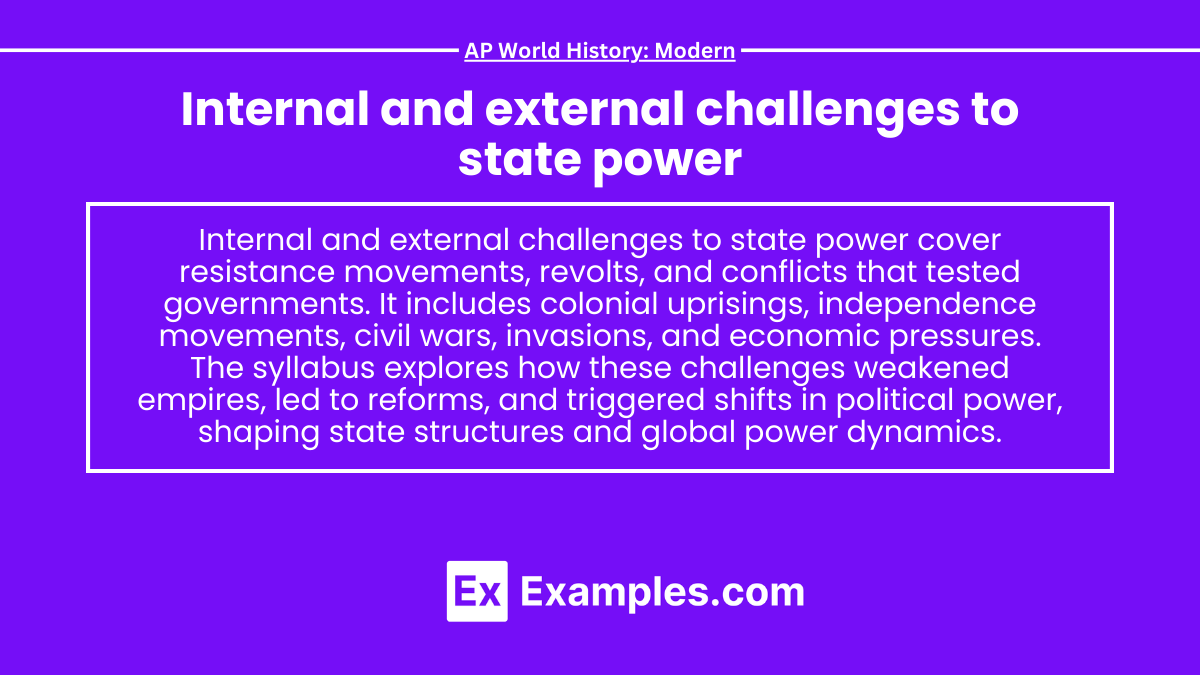Throughout history, states have faced numerous internal and external challenges that have threatened their power and stability. Internal challenges, such as rebellions, corruption, and economic instability, often weakened state structures, while external challenges, including invasions, imperialism, and diplomatic pressures, tested their resilience. Understanding these challenges is crucial to comprehending the complexities of political power and state transformations.
Learning Objective
In studying “Internal and External Challenges to State Power” for AP World History: Modern, you should learn to identify the key factors that threaten state authority, including political dissent, economic instability, and social movements within nations. Analyze external pressures such as military conflicts, imperialism, and global economic changes that challenge state sovereignty. Evaluate how states respond to these challenges through reforms, repression, or the adaptation of policies, and explore the long-term consequences of these challenges on state power, governance, and international relations.
1. Internal Challenges to State Power

Internal challenges to state power include civil wars, rebellions, revolts, economic crises, and political corruption. These factors weakened governments, caused social unrest, and forced leaders to implement reforms. The syllabus examines how internal dissent, ideological conflicts, and demands for rights or autonomy reshaped state authority, often leading to significant political changes.
- Rebellions and Revolts: Throughout history, internal revolts have been a significant challenge to state power. For example, peasant uprisings such as the Taiping Rebellion (1850-1864) in China emerged due to social, economic, and political grievances, weakening the Qing Dynasty’s control.
- Ethnic and Religious Conflicts: Many empires and states faced challenges from ethnic and religious groups seeking autonomy or resisting assimilation. The Ottoman Empire, for instance, faced numerous internal challenges from different ethnic groups such as Armenians and Greeks who desired independence.
- Corruption and Inefficiency: Corruption within governmental institutions often undermines state power. This challenge was evident in the later years of the Roman Empire, where corruption and inefficiency weakened administrative control and military effectiveness.
- Economic Instability: Economic problems like inflation, famine, and poor taxation policies have often led to internal dissent. The French Revolution (1789-1799) was partly fueled by economic hardships, taxation issues, and the fiscal crisis faced by the French monarchy.
2. External Challenges to State Power

- Imperialism and Colonialism: Many states faced threats from imperial powers seeking to expand their territories. For example, the colonization of Africa and Asia by European powers in the 19th century challenged the sovereignty of many states and resulted in the loss of autonomy.
- Invasion and Warfare: States have often been challenged by external military invasions. For instance, the Mongol invasions of the 13th century drastically altered the power dynamics in Asia and Europe, leading to the fall of several kingdoms.
- Diplomatic Pressure and Trade Conflicts: Diplomatic pressure, trade restrictions, and sanctions imposed by more powerful states have been significant external challenges. The Opium Wars (1839-1842, 1856-1860) exemplify how China faced external pressure from Britain, which led to the weakening of Qing state control and increased foreign influence.
3. Responses to Internal and External Challenges

- Military Reforms and Modernization: States often responded to challenges by modernizing their military. The Meiji Restoration in Japan (1868) is a prime example of a state responding to internal and external challenges by modernizing its military and industry, leading to Japan’s emergence as a major power.
- Legal and Administrative Reforms: Some states responded by implementing reforms to strengthen governance. The Ottoman Empire’s Tanzimat reforms (1839-1876) were an attempt to modernize and centralize the state in response to internal strife and external pressures from European powers.
- Alliances and Diplomacy: Forming alliances and engaging in diplomacy was a key response to external threats. The balance of power politics in 19th-century Europe involved states forming strategic alliances to counter potential aggressors, such as the Triple Alliance and Triple Entente.
4. Impact of Challenges on State Power

Challenges on state power weaken authority through economic crises, social unrest, political conflicts, and external threats. These forces disrupt governance, erode legitimacy, and create instability, making it difficult for states to maintain control, enforce laws, and address citizens’ needs effectively.
- Decline and Collapse of States: Persistent internal and external challenges often led to the decline or collapse of states. For example, the combination of internal corruption, economic decline, and external invasions led to the fall of the Byzantine Empire in 1453.
- Transformation and Adaptation: Some states adapted and transformed in response to challenges, resulting in political and social changes. The unification of Germany (1871) under Bismarck, for instance, was partly a response to internal divisions and external threats, leading to the creation of a powerful and centralized nation-state.
- Colonial Domination: External challenges, especially from imperialist powers, often resulted in the loss of sovereignty and the establishment of colonial rule, as seen in the British colonization of India.
Examples
Example 1: The French Revolution (1789-1799)
An internal challenge where economic hardship, political inequality, and social unrest led to the overthrow of the French monarchy, reshaping the nation’s political structure.
Example 2: The Taiping Rebellion (1850-1864)
An internal conflict in China caused by social, religious, and economic grievances against the Qing Dynasty, significantly weakening its control and leading to widespread destruction.
Example 3: The Mongol Invasions (13th century)
An external challenge where Mongol forces invaded numerous states, including China, Persia, and Eastern Europe, causing massive disruptions and the collapse of several empires.
Example 4: The Opium Wars (1839-1842, 1856-1860)
External challenges faced by China due to British imperialism and trade disputes, resulting in forced trade concessions, loss of territory, and weakening Qing state power.
Example 5: The Sepoy Mutiny (Indian Rebellion of 1857)
An internal revolt against British colonial rule in India, driven by political, economic, and religious grievances, challenging British authority but ultimately leading to tighter colonial control.
MCQs
Question 1
Which of the following best describes an internal challenge to state power in the 19th century?
A) Economic competition from other nations
B) Colonization by European powers
C) Nationalist uprisings within the state
D) Technological advancements
Answer: C) Nationalist uprisings within the state
Explanation:
Nationalist uprisings were internal challenges as they threatened the existing government’s authority, often demanding autonomy or independence from the ruling regime.
Question 2
What was a common external challenge faced by empires in the early 20th century?
A) Global pandemics
B) International military conflicts
C) Internal revolts
D) Economic self-sufficiency
Answer: B) International military conflicts
Explanation:
International military conflicts like World Wars posed external challenges by straining resources, leading to territorial losses and questioning the state’s power.
Question 3
How did economic imperialism serve as an external challenge to state power in the 19th century?
A) By promoting cultural assimilation
B) By enforcing trade monopolies
C) By strengthening state economies
D) By encouraging local craftsmanship
Answer: B) By enforcing trade monopolies
Explanation:
Economic imperialism imposed trade monopolies, limiting local economies’ independence and challenging states’ ability to control their resources and commerce.


